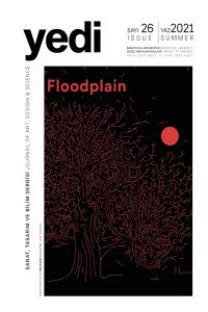Biyosanat: Selin Balcı ve Ayşe Gül Süter’in Biyosanat Projelerinin İncelenmesi
biyosanat, çağdaş sanat, yeni medya sanatı, Selin Balcı, Ayşe Gül Süter
Bioart: Investigation of Selin Balcı and Ayşe Gül Süter's Bioart Projects
Bioart, New Media Art, Contemporary Art, Selin Balcı, Ayşe Gül Süter,
___
- Antmen, A. (2010). 20. yüzyıl batı sanatında akımlar. İstanbul: Sel Yayıncılık.
- Atakan, N. (2008). Sanatta alternatif arayışlar. İzmir: Karakalem Kitabevi.
- Balcı, S. (t.y.-a). Statement. Selin Balcı. Erişim adresi: https://selinbalci.com/statement
- Balcı, S. (t.y.-b). Selin Balcı, Inter- and multi-disciplinary work. Baker Artist Portfolios. Erişim adresi: https://bakerartist.org/portfolios/selin-balci
- Balcı, S. (2012). Kontaminasyon II [Paneller üzerine küf]. Erişim adresi: https://selinbalci.com/mold-on-panel/1/31
- Balcı, S. (2014). Bordered World [Enstalasyon]. Erişim adresi: https://selinbalci.com/petri-dish-installations/1/1
- Balcı, S. (2015). 200 [Enstalasyon]. Erişim adresi: https://selinbalci.com/petri-dish-installations/1/30
- Byerley, A. ve Chong, D. (2015). Biotech aesthetics: Exploring the practice of bio art. Culture and Organization. 21(3), s. 197-216. doi: 10.1080/14759551.2013.836194
- 2018, O. ve Zurr, I. (2003). Disembodied Cuisine [Enstalasyon]. The Tissue Culture & Art Project, Crawley, Australia. Erişim adresi: https://tcaproject.net/portfolio/disembodied-cuisine/
- Catts, O. ve Zurr. I. (2004). Victimles Leather [Yarı canlı doku biyosanat yapıtı]. The Tissue Culture & Art Project, Crawley, Australia. Erişim adresi: https://tcaproject.net/portfolio/disembodied-cuisine/
- Catts, O. ve Zurr I. (2006). Towards a new class o being- the extended body. Artnodes, 6. doi:10.7238/issn.1695-5951
- Catts, O. ve Zurr I. (2008). Growing semi‐living structures: Concepts and practices for the use of tissue technologies for non‐medical purposes. Architechtural Design, 78(6), s. 30-35. doi:10.1002/ad.764
- Catts, O. ve Zurr, I. (2013a). The vitality of matter and the instrumentalisation of life. Architectural Design, 83 (1), s. 70-75. doi:10.1002/ad.1527
- Catts, O. ve Zurr, I. (2013b). Disembodied livestock: The promise of a semi-living utopia. Parallax, 19(1), s. 101-113. doi: 10.1080/13534645.2013.752062
- e-flux conversation. (2017, Şubat 13). Heather Dewey-Hagborg: “Hacking biopolitics”. Erişim adresi: https://conversations.e-flux.com/t/heather-dewey-hagborg-hacking-biopolitics/6045
- Erçel, S. S. (2019). Çağdaş sanatta alternatif sergi mekanları kullanımı: biyosanat ve biyosanat mekanları üzerine bir irdeleme (Yüksek lisans tezi). İstanbul Teknik Üniversitesi Sosyal Bilimler Enstitüsü, İstanbul.
- Hagborg, D. H. (2012). Stranger Vision [Enstalasyon]. Erişim adresi: https://deweyhagborg.com/projects/stranger-visions
- Hagborg, D. H. (2014). Invisible [Enstalasyon]. Erişim adresi: https://deweyhagborg.com/projects/invisible
- Hagborg, D. H. (2016). Postgenomic identity: art and biopolitic (Doktora Tezi). ProQuest Dissertations and Theses veri tabanından erişildi (UMI no: 10190390).
- Kac, E. (2000). GFP Bunny [Transgenik biyosanat yapıtı]. The Museum Of Modern Art, NewYork, USA. Erişim adresi: https://www.moma.org/calendar/events/6750
- Kac, E. (2003). GFP Bunny. Leonardo, 36 (2), 97-102.
- Kac, E. (2011). Bio art: From genesis to natural history of the enigma. In O. Grau, and T. Veigl (Eds.), Imagery in the 21st Century (p. 57-80), Cambridge: MIT Press.
- Kac, E., Jeantet M. L., Mangin B., Menezes M., Gessert G. ve Vanouse P. (2017). What bio art is: a manifesto. Erişim adresi: http://www.ekac.org/manifesto_whatbioartis.html
- Kallergi, A. (2008, Mayıs). Bioart on displaychallenges and opportunities of exhibiting bioart. kallergi.a. Erişim adresi: http://kallergia.com/bioart/docs/kallergi_bioartOnDisplay.pdf
- Melkozernov, N. A. ve Sorensen, V. (2020). What drives bio-art in the twenty-first century? Sources of innovations and cultural implications in bio-art/biodesign and biotechnology. AI & Society, 35(1). doi: 10.1007/s00146-020-00940-0
- Mitchell, R. (2010). Bioart and the vitality of media. Seattle: University of Washington Press.
- Osborne, P. (2017, 16 Mart). Çağdaş ne zaman başladı? e-skop. Erişim adresi: https://www.e-skop.com/skopbulten/cagdas-estetik-cagdas-ne-zaman-basladi/3309
- Radomska, M. (2016). Uncontainable life: A biophilosophy of bioart (Doktora tezi, Linköping Üniversitesi). Erişim adresi: https://www.dissertations.se/dissertation/d1cbe3fac1/
- Sharma, S. (2014). Bio-art: developing art through bio science. Everyman’s Science. 48(6), s. 405-408. Erişim adresi: http://www.sciencecongress.nic.in/pdf/e-book/Feb_March_2014.pdf
- Stracey, F. (2009). Bio-art: the ethics behind the aesthetics. Nature Reviews Molecular Cell Biology, 10, s. 496–500. doi:10.1038/nrm2699
- Süter, A. G. (t.y.-a). About. Erişim adresi: http://aysegulsuter.net/about/
- Süter, A. G. (t.y.-b). Works. Erişim adresi: http://aysegulsuter.net/
- Süter, A. G. (t.y.-c). Tear drop crystals. Erişim adresi: http://aysegulsuter.net/portfolio/tear-drops/
- Süter, A. G. (t.y.-d). Crystals in an artist’s studio. Erişim adresi: http://aysegulsuter.net/portfolio/crystals-in-an-artists-lab/
- Süter, A. G. (2016). Tear Drop Crystal [Fotoğraf]. Erişim adresi: http://aysegulsuter.net/portfolio/tear-drops/
- Süter, A. G. (2020). Crystals In An Artist’s Studio [Fotoğraf]. Erişim adresi: http://aysegulsuter.net/portfolio/crystals-in-an-artists-lab/
- Thacker, E. (2005). The global genome biotechnology, politics and culture. Cambridge: The MIT Press.
- Ünal, G. (2014, Ekim). Mikrorganizmalar sanatla buluştu: Bio-art. Skylife. Erişim adresi: https://www.skylife.com/tr/2014-10/mikroorganizmalar-sanatla-bulustu-bio-art
- Vaage, S. N. (2016). Amplifying ambiguities art on fringes of biotechnology (Doktora Tezi, Bergen Üniversitesi). Erişim adresi: https://bora.uib.no/bora-xmlui/handle/1956/12674
- Yetişen, A., Davis J., Coşkun F. A., Church M. G. ve Yun H. S. (2015). Bioart. Trends in Biotechnology. 33(12), s. 724-734. doi: 10.1016/j.tibtech.2015.09.011
- ISSN: 1307-9840
- Başlangıç: 2007
- Yayıncı: Dokuz Eylül Üniversitesi
Bauhaus Dokuma Atölyesi’nden Bir Kesit: Anni Albers, Otti Berger, Gunta Stölzl
Nuray ER BIYIKLI, Kenan SAATÇIOĞLU
Tasarım Aktivizmi Bağlamında Konu Odaklı Tasarımcılığın Dijital Platformlarının İncelenmesi
Tekstil Tasarımına Ekolojik Bir Yaklaşım: Lyocell Üzerine Doğal Boyama ve Eko Baskı
Özge ÖZEN, Özlenen ERDEM İŞMAL
D.E.Ü. G.S.F. Heykel Bölümü Atık Malzemeyle Heykel Çalıştayları
Gökcen ERGÜR, Sevgi AVCI, Levent AYATA
Biyosanat: Selin Balcı ve Ayşe Gül Süter’in Biyosanat Projelerinin İncelenmesi
Jean Genet Oyunlarında Törensilik Bağlamında Kurbanla Faili Aynı Bedende Okumak
EUROVİSİON ŞARKI YARIŞMASI’NIN MÜZİK DIŞI BOYUTLARI
İzmir Atatürk Evi Müzesi’ndeki İç Mekân Tekstiller Üzerine Bir Araştırma
Feminist Aktivizmin Temsil Alanı Olarak Sanat: Guerrilla Girls
